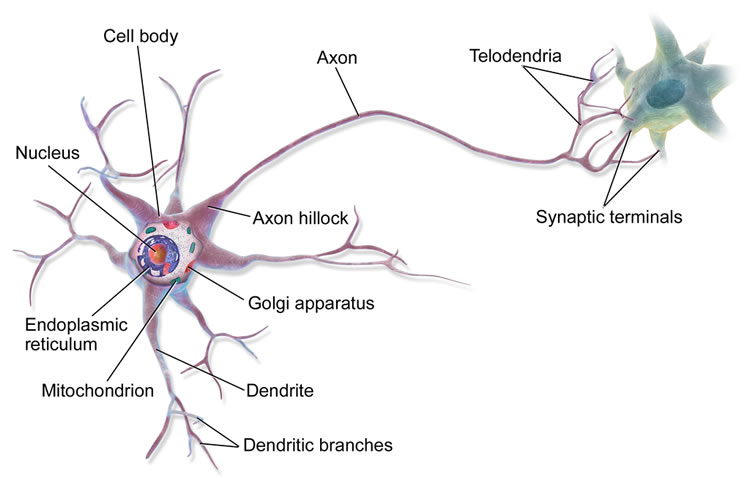Neurotransmitters and the Nervous System
Mindd Foundation

The production and synthesis of Neurotransmitters is a vital process in human health as these tiny molecules are the messengers between the central nervous system and all body systems including the brain and the gut.
A healthy gut microbiome is required for the production of our neurotransmitters which is a large part of why gut health impacts on concentration, mood, sleep, coordination and even IQ. Resolving and preventing leaky gut and gastrointestinal dysbiosis is essential for both physical and mental health.
Neurotransmitters Make the Difference
A neurotransmitter is a chemical messenger that carries and balances signals between nerve cells (neurons) and other cells throughout the body. Scientists have, to date, identified over 100 of these chemical messengers. Neurotransmitters have a wide range of physical and psychological functions including appetite, mood, concentration, sleep and heart rate (to name just a few). Billions of these tiny molecules work non-stop to keep our brains and bodies functioning.
Some neurotransmitters cause an electrical signal to be transmitted down the cell (“excitatory”) while others can block the signal (inhibitory). They can be affected by drugs, disease and one another given their highly interconnected network. When they are affected they may 1) be reabsorbed too quickly 2) produce too few 3) produce too many 4) be deactivated
While we often hear about activities to exercise and maintain a healthy brain (e.g. learning languages, playing an instrument, engaging in hobbies, meditating and socialising), we hear less about how neurotransmitters work or how to support them to positively influence outlook, memory, appetite, movement, addictions, migraines, intellectual performance and much more.
How your Nervous System Uses Neurotransmitters
Every day, the nervous system receives millions of signals from sensory organs: eyes, ears, skin, nose, and tongue. These signals allow us to read, listen to music or taste food. It also controls the movement of every muscle fiber in the body (including the cardiac muscle of the heart, and the smooth muscle of your entire digestive tract).
The nervous system also responds to the ever-changing chemical environment of your body, such as fluctuations in mood, acidity/alkalinity, or inflammation, to name just a few. Neurons communicate with one another by transmitting signals from one cell to another across the synapse (a tiny gap at the end of each neuron). This communication across the synapse is called neurotransmission where the neurotransmitter attaches to a “receptor site” on the other neuron where it either excites or inhibits depending on the type of neurotransmitter.
By looking at individual neurotransmitters, we can begin to appreciate the minute and unique actions of these chemical messengers. Below is a summary of the key neurotransmitters and the role they play in activating body functions.

Figure One: Diagram of a typical neuron (nerve cell). Neurotransmitters are produced in the cell body of neurons, before being released outside of the cell, as needed.
Image credit: Neuroscience News. http://neurosciencenews.com/fluid-flow-neuron-growth-1402/neuron-diagram/
Acetylcholine
Acetylcholine (ACh) was the first neurotransmitter ever discovered. Out of all neurotransmitters, ACh is probably the most far-reaching. It is involved in nerve impulse transmissions in both sympathetic (stress) and parasympathetic (rest/digest) responses throughout every cell and organ in the body.
Its name comes merely from its chemical structure; ‘acetyl’ is a tiny chemical species that contains only a little carbon and hydrogen (C3H6), while choline is more like a lipid (fat). We make our own Ach and do not need to obtain it from food or supplements. Without ACh, our nervous system would cease to function. Diseases like Alzheimer’s disease show a marked reduction in ACh concentrations in specific areas of the brain, while Myasthenia gravis is an autoimmune disease affecting the role of ACh in muscle contraction.
Histamine
Generally not appreciated as a neurotransmitter, histamine is well known for its role in allergy and inflammation. However, its role as a neurotransmitter is essential for keeping us awake (hence the reason why antihistamines generally make us drowsy). It is synthesized in the body via the amino acid, histidine. Again, histidine is readily supplied by most foods in our diet.
Functional practitioners recommend low histamine diets in treating allergies and food intolerances which can successfully reduce hives, rashes, sneezing and gut pain. Additional benefits of a low histamine diet include a reduction in migraines, drowsiness, and moodiness.
Adrenaline and Noradrenaline
Adrenaline (epinephrine) is both a neurotransmitter and a hormone. It is synthesized in the adrenal glands and some neurons. It is an excitatory neurotransmitter, with low levels being associated with fatigue, inability to focus, reduced attention span, difficulty sleeping and difficulty losing weight. Interestingly, these are often symptoms described by individuals under high stress, with adrenal exhaustion.
Noradrenaline (norepinephrine) is related to adrenaline but is far more widespread throughout the body. Like adrenaline, it is excitatory; thus it increases wakefulness, alertness, and vigilance. It is elevated during stress, driving the ‘fight or flight’ response which allows us to focus and retrieve memories. It also increases restlessness and can promote anxiety. Generally, high levels are associated with prolonged stress and ADHD.
Serotonin
Serotonin is regularly referred to by its more chemical name, 5-hydroxytryptamine (5-HT). Serotonin is another of our neurotransmitters derived from an amino acid; in this case, tryptophan. Tryptophan is an essential amino acid; we must supply it to our body via our diet.
90% of the Serotonin in the human body is located in the gastrointestinal (GI) tract, making this neurotransmitter extremely interesting to medical science. Not only does serotonin regulate motility of the GI tract, but it is also involved in central nervous system functions such as sleep, appetite, mood, learning, and memory. Clinically, abnormalities of serotonin function have been linked with an array of health conditions from over-eating and obesity, through to major depression, obsessive-compulsive disorder (OCD) and anxiety. The emerging scientific evidence linking gut health with mental health is due in part to the activity of serotonin in these two anatomically separate, yet biochemically related organs.
Glycine
Glycine is an amino acid neurotransmitter, which is non-essential in the diet. It can be synthesized in the human liver, but this relies on the adequate supply of activated vitamin B9 from our diet.
Glycine is simple in its molecular structure (it is the smallest amino acid). It functions primarily in the spinal cord, having inhibitory effects on information that co-ordinates movement, vision, and hearing. It assists in reducing hyper-excitability of the nervous system, with some studies linking low glycine levels with hyperactivity, schizophrenia, bipolar disorder, and epilepsy. It also plays a role in reducing systemic inflammation including in the gut where it plays a healing role with the help of bone broth and other animal sources like meat and collagen.
Glutamate
Glutamate is the major excitatory neurotransmitter of our nervous system. It links in with pathways for many of the other neurotransmitters Receptors responding to glutamate are located throughout our brain and spinal cord.
Glutamate comes from the amino acid, glutamic acid (it is the base pair of this acid). Humans synthesize glutamate within our nerve cells from a range of precursor substances, including glutamine. As glutamate is excitatory in its role, it’s responsible for cognition, memory, and learning. In diseases involving glutamate, this neurotransmitter can accumulate outside of nerve cells, continually stimulating them and leading to excitotoxicity. This can eventually lead to the destruction of functional nerve tissue. Examples include Alzheimer’s disease and the cascade of destruction that follows a stroke.
Gamma-aminobutyric acid (GABA)
GABA is the inhibitory neurotransmitter partner of the excitatory glutamate. These two neurotransmitters work together to balance brain activity. While it may sound negative to have inhibitory effects on the nervous system, GABA is vital for the sedation that precedes sleep, and it is imperative for relaxation. It also supports vision and motor control.
Humans synthesize GABA in the brain from its excitatory partner, glutamate. Again, vitamin B6 is required for this biochemical conversion. Supplements of GABA do exist, mainly for the treatment of hyperactivity and poor sleep. However, there is no evidence GABA taken orally will cross the blood-brain barrier to reach GABA target nerve cells in the brain. Additionally, the human body is very proficient at GABA regulation, meaning supplementation is likely ineffective.
Gasotransmitters
- Nitric Oxide is produced by the endothelial cells lining the arteries and plays a key role in blood pressure by relaxing muscles and increasing blood flow by dilating blood vessels. Along with Carbon Monoxide, it plays a key role in regulating the enteric nervous system and impacts on intestinal motility and transit time (i.e. can inhibit muscles that result in constipation).
- Carbon monoxide protects the gut from several types of gastrointestinal injury. It is produced naturally by the body to help modulate the body’s inflammatory response.
Neurotransmitters and their Actions
Type |
NeurotransmitterName |
Plays a role in: |
ActionInhibitory (Calming) or Excitatory (Stimulating) |
How to support |
| Amino Acid | GABA | Supports vision and motor control. Supports relaxation and regulates anxiety. | inhibitory | Lactobacillus & Bifidobacterium synthesize it |
| Amino Acid | Glutamate | supports memory and learning. | excitatory | |
| Amino Acid | Glycine | fights systemic inflammation, gut healing, detoxes methionine | inhibitory | animal products (meat, bones, skin, collagen) |
| Peptide | Oxytocin | supports social recognition, bonding and sexual reproduction | excitatory | social interaction, pets |
| Peptide | Endorphins | inhibits pain signals and promotes euphoria | inhibitory | exercise, sex, chocolate |
| Monoamine | Epinephrine | also is known as adrenaline which is released in response to stress | excitatory | |
| Monoamine | Norepinephrine | triggers the fight or flight response in times of danger or stresses | excitatory | Escherichia, Bacillus, Saccharomyces synthesize it |
| Monoamine | Histamine | plays a role in allergic reactions and supports the immune system’s response to pathogens | excitatory | |
| Monoamine | Serotonin | mood, sleep, anxiety, depression, sexuality, appetite | inhibitory | Candida, Streptococcus, Escherichia, Enterrococcus synthesize it |
| Purine | Adenosine | suppressing and arousing sleep | inhibitory | |
| Purine | Adenosine Triphospate (ATP) | autonomic control, sensory activation, communication with glial cells | inhibitory | |
| Gasotransmitters | Nitric Oxide | muscle relaxation for improved blood flow | inhibitory | |
| Gasotransmitters | Carbon Monoxide | modulates inflammation in the body | inhibitory |
Research and Writing
Annalies Corse, ND. and Leslie Embersits




